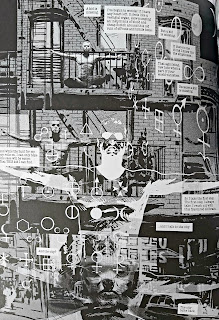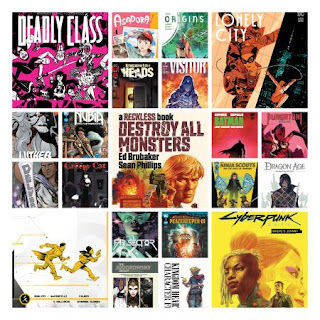Happy Halloween!
This time last year I wanted absolutely nothing to do with horror. Burned out and trying not to get too depressed about the state of the world, I went absolutely anti-horror and instead put together a bunch of Instagram posts for All Star that I called “ambient comics,” showcasing moments of peace in comics from all over the world and trying to encourage some mindfulness I myself greatly needed.
For whatever reason, I’m back full force into horror mode this year. I do appreciate, however, that many readers may not be, so I thought carefully and this year we are going for mood, atmospherics and absolutely gorgeous art over fright, transgression and bloody violence.
I hope you’re well and if you’re able to enjoy some spookiness this year, may you get the good, cathartic scaring you’re after.
FEATURED COMIC:
HOPE...FOR THE FUTURE
Guy Adams and Jimmy Broxton
Rebellion/2000AD
Of all the genres you can smash together to make weird Frankenstein monster-fiction out of, the two most surely suited are Crime and Horror. Within this expanded genre territory we can get even more specific, as Noir and the Occult have enjoyed a long and fruitful affair and have produced offspring in all media, generally referenced as Supernatural, Paranormal or Occult Noir.
The pairing is obvious. Noirs often feature dark, occasionally perverse, mysteries with tortured, frequently self-destructive characters. My favourite definition of noir was coined by writer Anthony Neil Smith, who said that noir is essentially about characters “circling the bottom of the drain.”
Occult stories often feature dark, damaged characters who are seekers of the arcane. The word Occult even means hidden or obscured. There’s often a comparable sense of futility and predestination in both noir and horror; the ultimate terrible reveal unavoidable and inevitable.
Lazily rattling a few Occult Noirs off the top of my head, we have Ed Brubaker and Sean Phillips’ Fatale comic (2012-2014), the quintessential comics occult noir of John Constantine: Hellblazer, William Peter Blatty’s film The Exorcist III (1980) and William Hojbjerg’s novel, Falling Angel (1978) and it’s subsequent movie adaptation, Angel Heart (1987) directed by Alan Parker.
Falling Angel is a perfect example for our purposes here, as it features an Occult Detective, a figure that’s been utilised and recast so frequently it is almost cliche at this point. There’s a heap of them in comics also, with characters from Joe Golem to Dylan Dog to John Constantine (not a true “P.I.”, sure, but certainly close enough) having long, healthy runs.
Into this fertile space comes writer Guy Adams and artist Jimmy Broxton’s character Mallory Hope. Hope’s had two adventures so far, both originally serialised in 2000AD and subsequently collected into handsome trade paperback editions. I admit, I slept on the character. You might have as well. Do we really need another gumshoe occultist in our lives? I didn’t think so, but the character’s first collection, Hope...for The Future (2018) is brisk, snappy, clever and gorgeously illustrated. There might just be room on the racks for another spell-casting PI yet.
The back cover tells us that we are in an “alternate post-war 1940s Los Angeles, where occult forces are a fact of life.” Magic might be pervasive in this world, the US won World War II with its use, but characters aren’t walking around just bumping into sorcerers or anything like that. There’s more of an acceptance that occult forces are at play in regular life in this world, particularly in this LA, where the darker side of tinseltown is blacker than its packed movie theatres when the lights go down.
So, yes. Enter Mallory Hope. A PI with a tortured past and magical ability. Using magic is not a pleasant experience for Hope, however, and the consequences of his spells manifest in two ways. Physically, using magic wrecks Hope. “Using magic is like drinking methylated spirits,” his first person narration tells us early on, “it gets the job done but rots away at your insides.” Then there’s the matter of Cade, the paranormal entity that’s attached itself to Hope and especially enjoys it when the PI’s circumstances involve magic, pain, turmoil and violence.
Cade is one of the title’s real mysteries. There’s of course the matter of the case that drives Hope...for The Future’s plot (we’re getting to that), but at the heart of the character himself is what’s happened to his missing family and just how Cade, this shroud-clad, gas-mask wearing spook ended up as something like Hope’s nightmare pain familiar. If you want to get heavy, she’s a manifestation of Hope’s grief and, well....hopelessness.
Hope is hired to find a missing child. It’s a case that hits close to home for him - his own son is missing, it’s hinted he’s been dragged to hell, or someplace equally demonic - and it’s a case that also draws him into, yes, the sordid, seamy, underbelly of Hollywood.
The missing boy is Joey Fabrizzi, better known as child actor sensation, Buster Ritz. Fabrizzi’s mum is a bombshell, his father a violent, greedy man. Yes again, all your noir tropes are here and by now you might be rolling your eyes a bit as much of this is just oh-so familiar.
As with anything, it’s the execution of all of these elements that makes this comic either sink or swim and both Adams and Broxton appear to have put everything into this comic to ensure it floats. Adams script just motors along, likely the byproduct of Hope’s initial serialisation in 2000AD, and his writing largely crackles with energy, wit and terse narrative captions. Adams is also smart enough to get out of his collaborator’s way as often as he possibly can. You probably would too if you were working with Jimmy Broxton.
Broxton’s the absolute star here and his shadowy, inky black and white work is enhanced by the thick, crisply white matte paper Rebellion wisely published the collection on. Broxton’s digital effects are in-synch with his fluid pen and brush strokes. Diaphanous magical sigils flow across pages like a musical score, for example, perfectly accompanying his detailed cartooning. Broxton’s work is suitably classical - real in that Wally Wood, Al Williamson way (he and Adams previously collaborated on Goldtiger, a “lost” 1960s adventure comicstrip, so this style is clearly in his DNA).
Broxton also clearly loves noir, but his blackwork never obscures or cuts corners of the incredible attention to period detail throughout. In terms of both story and art, Hope’s post-war world is as fleshed out and tangible as you’d wish for. There’s clear affection and warmth for all the conventions of noir storytelling. You can call them cliches if you prefer, but that would be a clear disservice to the creative teams efforts.
If I have to nitpick the visuals, it would be Hope’s unfortunate similarity to aforementioned John Constantine - the fair hair, the trenchcoat - it’s a hard association to shake when reading the comic and it’s one you’ll inevitably also make. Still, when art looks as good as this, it’s hard to complain:
Of course, there’s no happy ending here but we are left with a glimmer of hope for our protagonist as Adams and Broxton close the curtain on their opening chapter. The irony of having a character named “Hope,” and then giving him none, is gone and readers intrigued enough (as I am) to seek out the second volume, Hope Under Fire, should be prepared to meet someone whose surname is more of a statement of future intent, manifested almost like another kind of magic, whose world-view is reshaped somewhat optimistically. And as we all carefully, cautiously, pop our heads finally(?) out of protracted lockdowns, there’s perhaps nothing more relatable than that.
WHAT MADNESS IS THIS: STRANGE THINGS FROM THE SHELF
RANPO PANORAMA
Suehiro Maruo
Beam Comix
In 2010, Suehiro Mauro, Japan’s master of ero-guro (erotic grotesque), unleashed Ranpo Panorama, a collection of illustrations inspired by the work of the godfather of Japanese crime fiction, Edogawa Ranpo. Ranpo, whose real name was Tarō Hirai, is a massive pop cultural influence in Japan and took his pen name from the father of detective fiction, Edgar Allan Poe.
Maruo has adapted many of Ranpo’s stories, probably most familiar to Western readers would be The Strange Tale of Panorama Island, which came out in English from Last Gasp. Ranpo Panorama (2010) functions as a sort of gallery of Maruo’s love for Ranpo, with 50-plus illustrations and collages such as the above ranging from the bizarre to the shocking to the surreally serene. Also included is an adaptation of a typical Ranpo oddity, The Midget Is Dancing. Oh yes.
UPCOMING UNDER THE RADAR
DISCIPLES
Benjamin Marra, David Birke and Nicholas McCarthy
Fantagraphics
Coming next April (don’t say you weren’t warned) is Disciples by Ben Marra and filmmakers David Birke and Nicholas McCarthy. Promising to channel “the best of 1970s era eerie-thriller-terror movies in a fresh and revelatory way,” Disciples features one of my own personal favourite obsessions - a creepy cult.
I’m going to steal wholesale from Fantagraphics’ PR here as I’m short on time, I’ve obviously not read this and I don’t think Fanta will care:
“Marin County, 1978. In this graphic novel, teens Clara and Wendy get high one night alone at home. Before the night ends, they've disappeared — until five months later, when Clara is found, disheveled, but alive, in Death Valley National Park.
From Clara's mysterious reappearance in Death Valley, Disciples cuts to the present day, where stories of "The California Cult" and its enigmatic — and never-caught — leader, Billy Joe, are as much a part of the popular culture as the Manson Family. Clara, the lone survivor of the cult, has adopted a new identity to protect her and her daughter, Wren. And she mostly does, until one night when the past and present horrifically collide.”
Sounds awesome.
NEXT TIME:
Holy crap, it’s entirely likely that unless I actually manage to write about my bizarre obsession with reading almost nothing but Judge Dredd comics during the last stretch of lockdowns, I’ll be back at the end of the year for what’s probably going to be a personal Best of 2021 as well as the annual Forecast column for 2022. Where has the year gone?
Unbelievable.











